Open Source Strategy

Victor Lu - independent
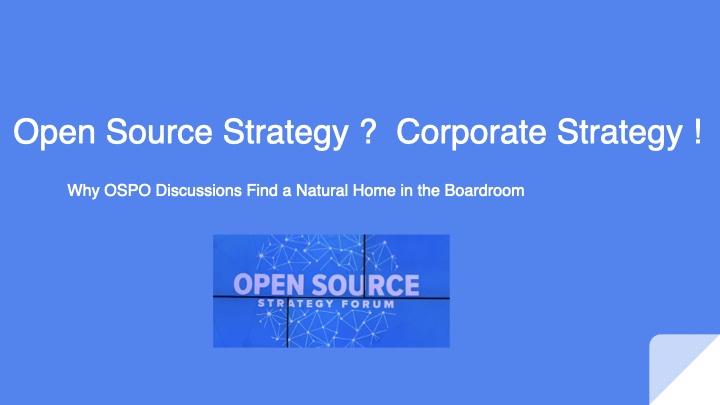
The integration of open source is steadily becoming a fundamental element in corporate strategies. The FiNOS foundation is ideally positioned for Open Source Program Office (OSPO) professionals to collaborate and emerge as a strategic force within corporate boardrooms.
As a database consultant, I've discovered my life's passion: contributing to the world by utilizing my natural ability to absorb extensive information, similar to Generative AI/ChatGPT. Rob prompted me to capture our discussions on the FINOS Open Source Maturity model, making this presentation a joint effort between Rob and Victor.
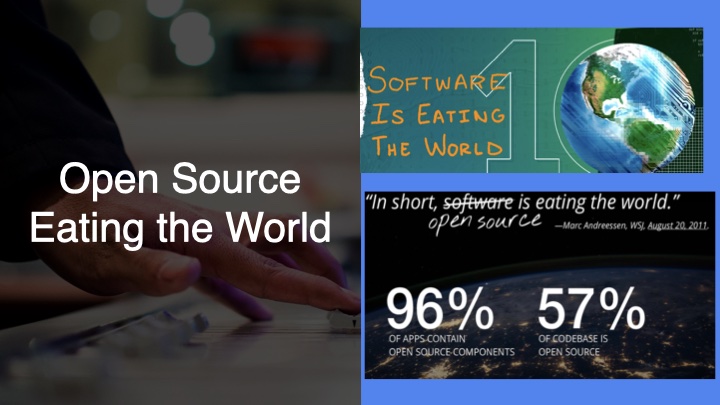
For quite some time, it has been widely acknowledged that software is reshaping the world. The influence of open source is increasingly pervasive in the software domain, leading us to assert that open source (software) is reshaping the world.
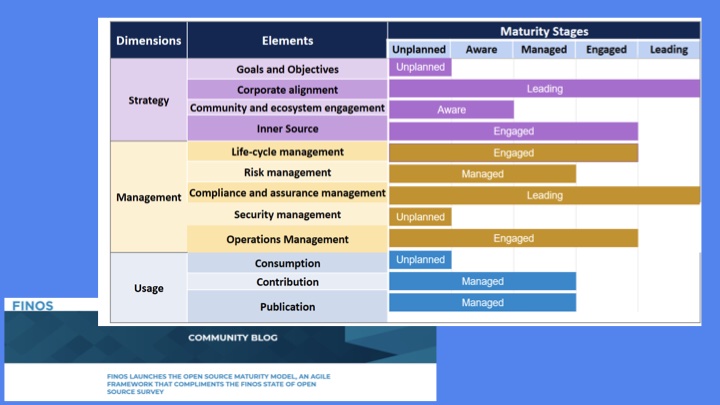
The Open Source Maturity Model was unveiled at the Open Source in Finance Forum in New York City on December 8, 2022. This model plays a crucial role in assisting companies in assessing their position on the open-source adoption journey.
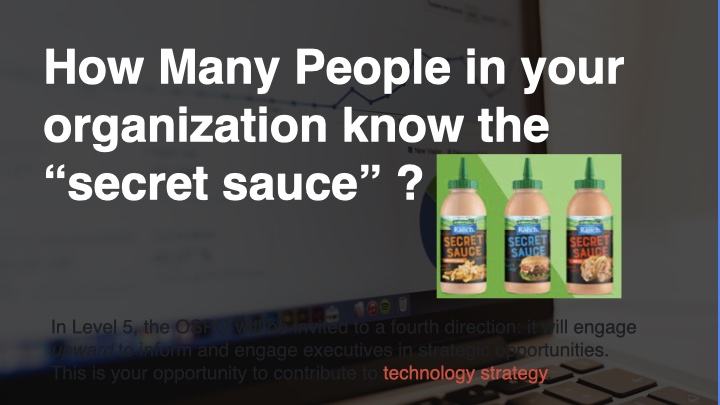
The existing FINOS open source maturity model explicitly outlines that, at Level 5, Open Source Program Offices (OSPOs) are required to actively involve themselves at higher levels, establishing a connection between corporate strategy and technology strategy by engaging with executives. There's a saying that in the largest organizations worldwide, fewer than 30 individuals are privy to the organization's secret source. To effectively engage upward with executives, it becomes essential for an Open Source Program Office (OSPO) to comprehend the intricacies of the organization's strategy. Throughout this presentation, we have used the terms "corporate strategy" and "organization strategy" interchangeably, given that the majority of financial institutions are private corporations.
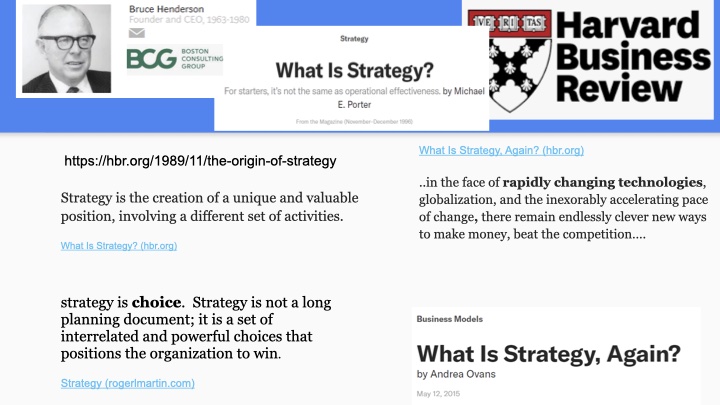
Firstly, let's delve into the concept of strategy. In the early 1960s, Boston Consulting Group founder Bruce Henderson emphasized the importance of gaining a relative market share advantage to achieve lower costs than competitors. This strategy, according to Henderson, allows a firm to continually reduce costs through a learning curve advantage. In 1980, Michael Porter introduced another competitive approach: differentiation. Porter's generic strategies gained significant popularity in both classrooms and boardrooms. However, confronted with swiftly evolving factors like new technologies, corporations find themselves compelled to undertake extensive architectural efforts to establish the link between technology and corporate strategy.
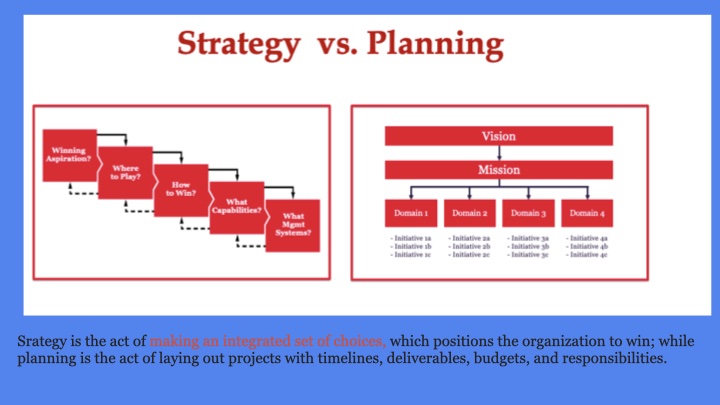
Divergent viewpoints exist on whether strategic planning is inherently strategic. This stems from the distinction between strategy, which involves making a cohesive set of choices, and planning, which entails outlining projects with timelines, deliverables, budget constraints, and responsibilities. For top executives privy to the organization's secret sauce, it is evidently imperative to narrow down choices to a select few that hold utmost significance for the organization's success.

To glean insights from the leaders in corporate strategy, it is essential to scrutinize the methodologies employed by strategy consultants at McKinsey, BCG, and Bain over the years. A notable observation is that many frameworks were crafted by assessing the strategic landscape of their clients. This involved interviews with top executives, who possess knowledge of the organization's secret sauce, as well as interactions with relevant individuals throughout the organization, including those in various lines of business.
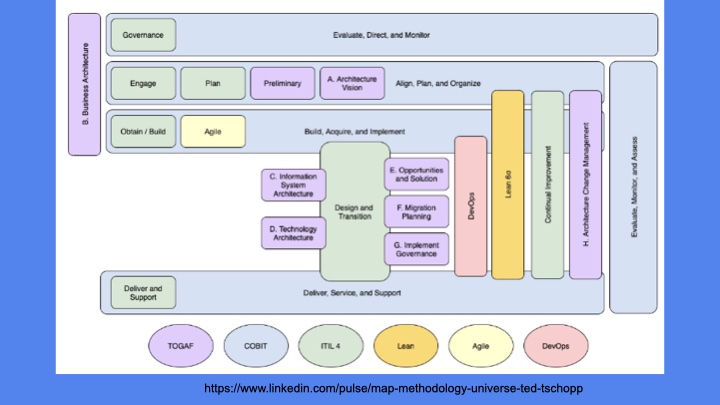
Enterprise architecture frameworks, such as TOGAF, have proven instrumental in aligning corporate strategy with the technology domain. We consider these frameworks to be a valuable repository of knowledge that can be effectively utilized. Furthermore, given the dynamic nature of the continually evolving open-source landscape, it becomes imperative to engage in ongoing discussions that provide updated insights into the financial industry and the open-source technology landscape. This ensures that top executives are equipped with the latest technological perspectives and understand their relevance to the corporate strategy. (As a side note, Communication from the top-down is more straightforward in a small startup due to their size, small startups also often concentrate on achieving product-market fit and generally allocate less time to "strategy")
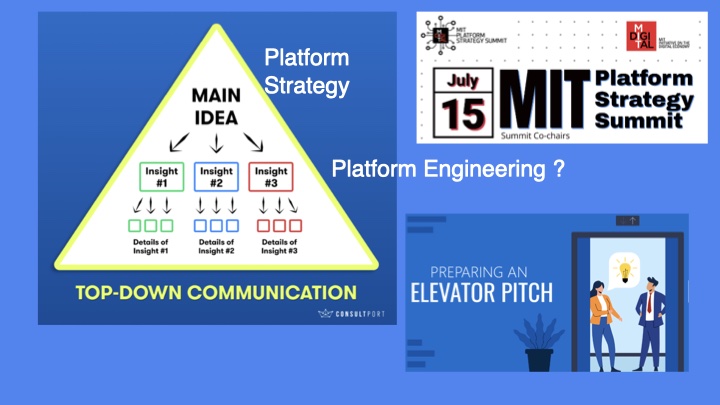
In most organizations, there are innovative ideas and methodologies, yet a common issue is the breakdown in communication between various departments. The most significant consequence of this breakdown is the disconnect between top executives and the practical realities in the line of business, including technologists. Consider a scenario where distinct terminology is used in a meeting, and top executives allocate less than 5 minutes for presenting a point—a situation exacerbated by the communication breakdown.

Having recognized the significance of comprehending corporate strategy as a prerequisite for defining an enhanced FINOS open source maturity model and facilitating communication within the organization and among FINOS corporate members, let's look at some key intersections between open source and business strategy in financial services
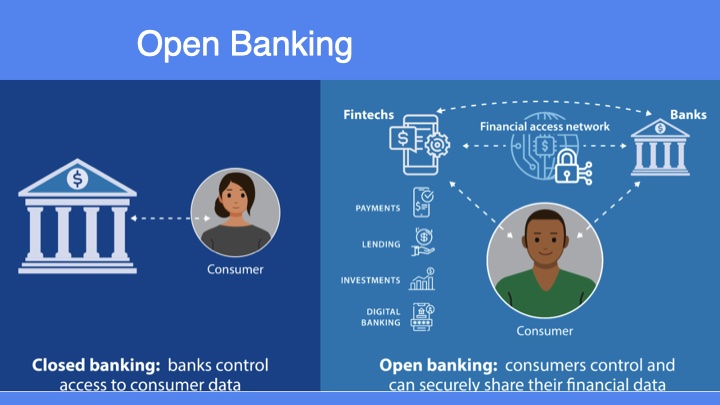
Discussing open source in the financial industry inevitably involves addressing open banking. The open banking framework promotes the secure and efficient sharing of customer financial data with third-party providers, all contingent on the explicit consent of the customer. For top executives in financial institutions, delving into the intricacies of the open banking landscape is of paramount interest. The FINOS foundation serves as an ideal platform to explore these details, providing a concise overview of the choices executives can make to adopt open banking standards and solutions.
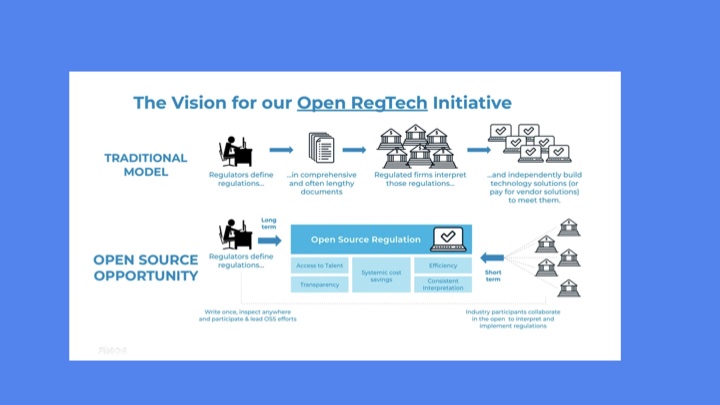
The Openreg initiative, part of FINOS, develops open-source solutions for regulatory compliance. This is crucial as the current market relies on costly, inefficient, and challenging-to-manage custom-built solutions.
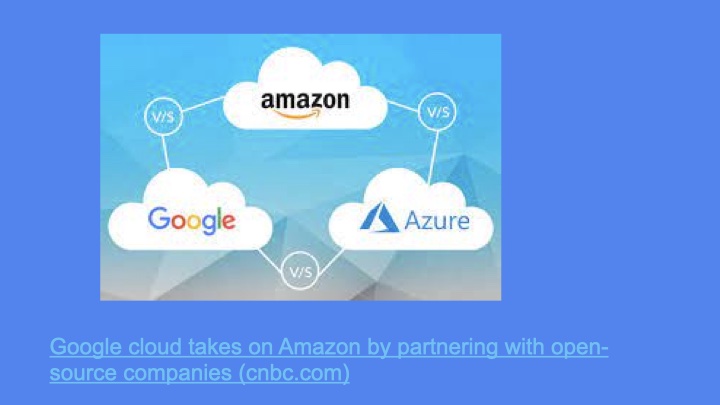
The open-source community surpasses the size of any organization globally. Irrespective of an organization's scale and technological prowess, there are always strategic choices available for that organization to become a significant player in its industry.
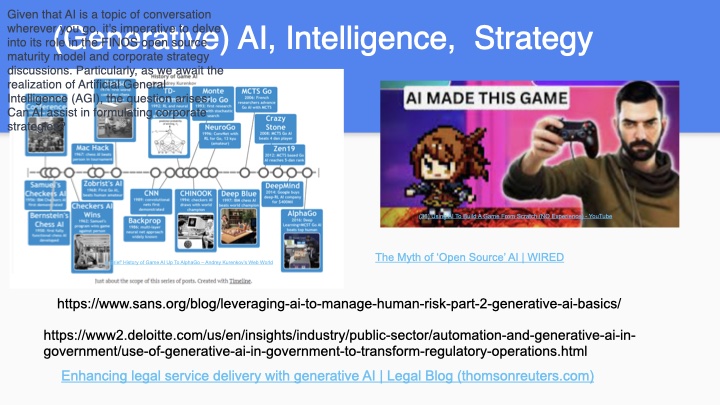
Given that AI is a topic of conversation wherever you go, it's imperative to delve into its role in the FINOS open source maturity model and corporate strategy discussions. Particularly, as we await the realization of Artificial General Intelligence (AGI), the question arises: Can AI assist in formulating corporate strategies?
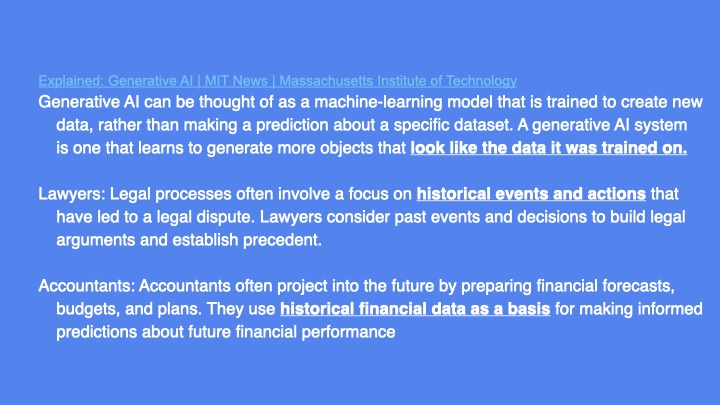
Certainly, opinions may vary on whether AI, in the short term, possesses the creativity to formulate corporate strategy. Nonetheless, considering that AI primarily learns to generate outputs based on existing data, our prediction is that current AI systems may struggle to devise novel strategies without a deep understanding of disruptive technologies and their implications for the industry landscape and society as a whole.
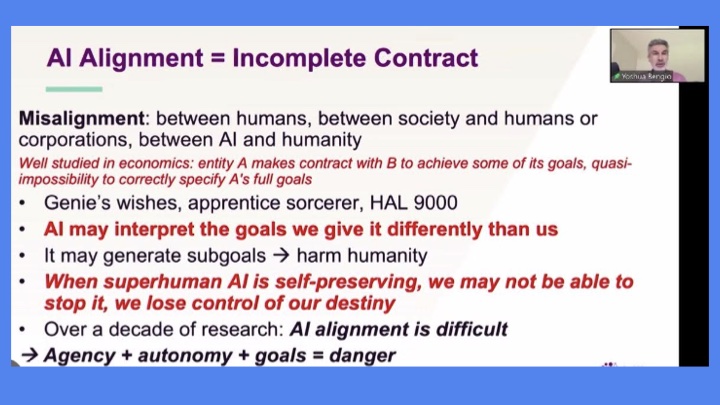
Certainly, AI scientists have foreseen the emergence of Artificial General Intelligence (AGI). Nevertheless, relying on AGI to make strategic decisions for organizations or individuals may not always be advisable, as the role of AGI may not consistently align with human goals and values.
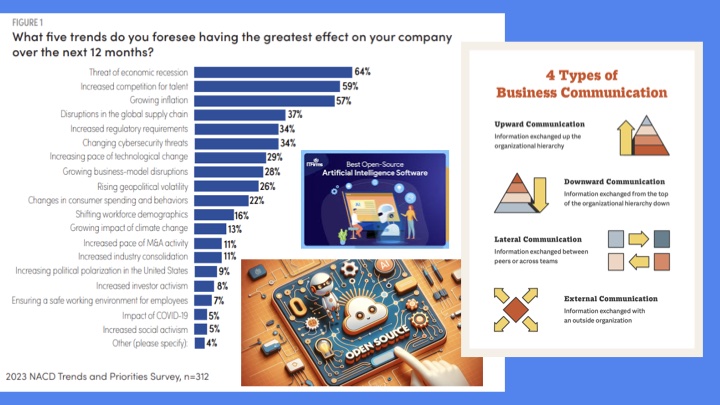
So, we’ve looked at just a few technologies which are likely to have a major impact on business strategy. But there are many more! In fact, there are firms that specifically survey industries to find out which are the most important external factors that affect business strategy. Technology is number 7 on this list. The question is then, is the OSPO as a centre of excellence around technology change doing enough to alert the strategic decision makers in the firm about the risks? This would be a classic “upward communication” problem - how do you make sure important messages reach those people in the firm?
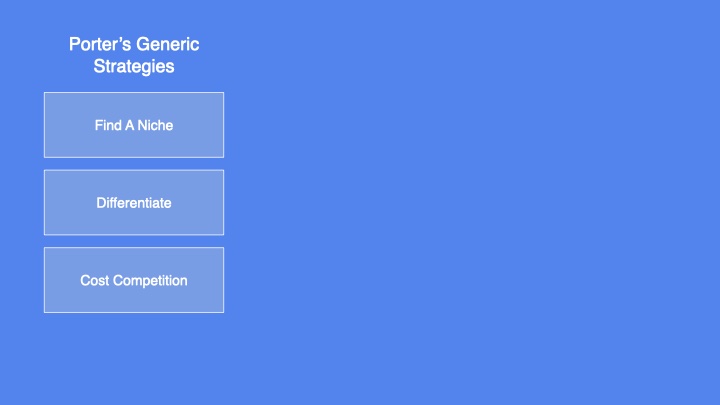
(Rob) In the latter half of the 20th Century, Michael Porter was the strategy guru. One of his ideas was that there were 3 basic “generic” strategies that a firm could apply. Let’s say you are in a highly competitive industry with lots of other firms. How do you win market stare from those firms?
Way 1 is find a niche: identify a lucrative sub-group within the market and meet the needs of those people specifically. An example of this might be Timex or Rolex: they’re both watch companies, but they’re selling to different parts of the market. Arguably, Rolex are actually a jewellery company, which is in the niche of jewellery as watches.
Way 2 is to differentiate: that is, create varieties of your product to better fit the needs of the different sub-groups within the market. Samsung try to do this in the phone market, for example, by having a wide variety of differently priced handsets, from the flagship phone models to budget ones.
Way 3 is cost competition. That is, removing as many frills as possible in order to undercut your competitors. RyanAir is a good example of this in the UK - a budget airline that beats the prices of everyone else by offering an extremely limited service and a streamlined, standardized product offering with as much automation as possible.
But, how does this apply to open source?
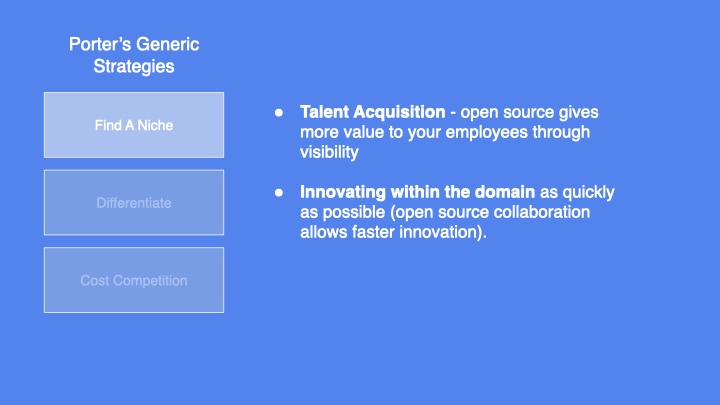
(rob) You can use open source to help find a niche. For example, your firm could be the leader in Open Source in Financial Services, and attract talent. We see Facebook attempting this strategy with their AI work and tools like React.
Or you could use open source collaboration as a way of innovating in a domain faster than your competitors. For example: AWS uses plenty of open source software, often just providing that as a service.
Applying an open source technology, such as AI might enable you to service a particular niche within your industry. Adopting open source standards might allow you to sell within markets that are using those standards (for example, FDC3)
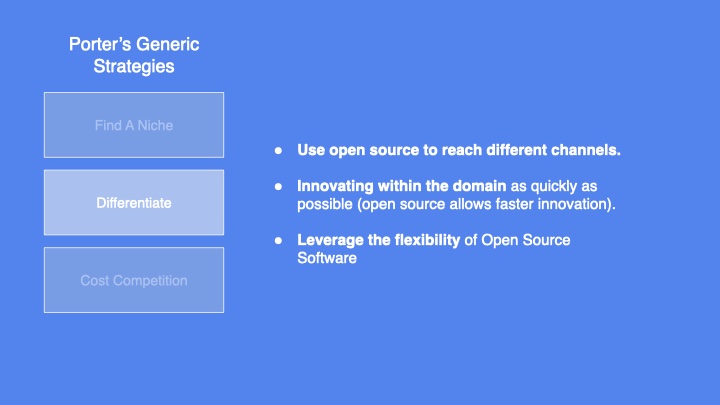
(rob) Differentiation is about serving your product to different sub-sections of the market. We’ve seen this with technology generally. For example, Internet Banking really is just banking, but it’s via a different channel than going into the branch. In India and China, messenger services like WhatsApp and WeChat are being used as a new banking channel. AirBnB created a whole new category using the internet. Open Source software can help build access to these channels. Will there be AI-agent based channels in the future? Maybe.
Often, open source software is more flexible and adaptable than internally developed software. Can you apply it and use that flexibility to differentiate your product? Larger financial services firms often see their internal systems as generators of business value - their secret sauce. But, an alternative view is that those systems are ossified and solving yesterday’s problems. Can you apply open source to create new products within the marketplace?
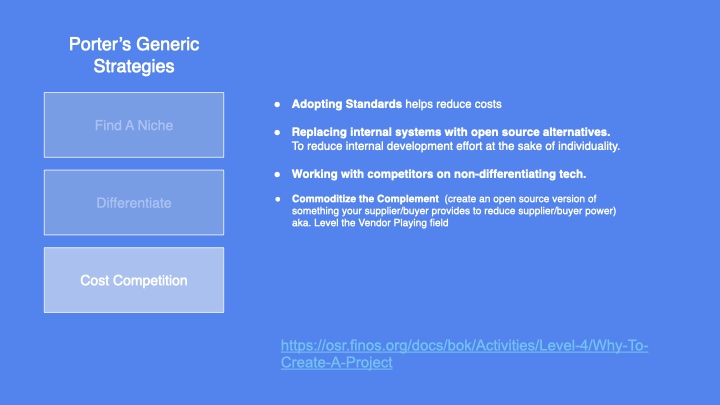
(rob) Open Source can really help with cost competition. You can beat your competitors by junking your proprietary systems and replacing them with open source alternatives. This is at the expense of individuality, and possibly also at the expense of customer experience. WhatsApp - used Elixir language to support billions of users with ~30 developers
Another alternative is to work with competitors on the non-differentiating technology. By working as a team (or, a Peloton, in cycling terminology) the individual effort is lessened and costs come down. This is why Open Reg Tech is such an attractive prospect. Obviously, Linux itself is a poster-child example of this. But there are plenty of others: software like Typescript and React originally were built to satisfy in-house engineering issues but were open sourced to reduce cost of ownership, improve the technologies themselves and also increase goodwill and have a positive reputational impact.
Commoditizing the complement means creating an open source version of something your competitor, buyer or supplier does. This means, that functionality is no longer a strategic advantage to them. An example of this is Google creating Chrome to compete with Microsoft’s Internet Explorer, or Kubernetes to compete with Amazon’s AWS.
Look at your own software stacks: what would you be better off not owning? What would it be better to collaborate with your peers on? Why not donate that to FINOS!
Finally, this link is a page written by Peter Smulovics which talks about a lot of these strategies on the Open Source Readiness website.
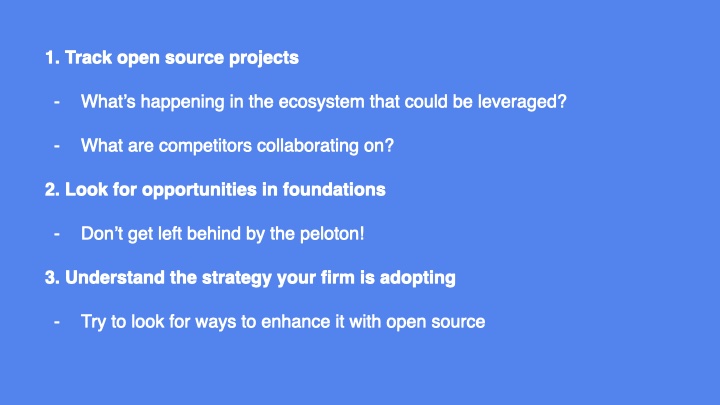
(rob) Porter’s model is just one lens for looking at business strategy. There are others. But, it’s an interesting way to look for insights.
What are the take-aways for people working at the intersection of open source and strategy, then?
Here are three things to think about doing to achieve the level 5 maturity in the model:
Track what’s happening in the open source world. What projects are up-and-coming? What trends should your strategists know about? What are your competitors working on? Also, what are your internal development teams using, that is of strategic significance? Are you devoting enough resources to making sure those projects are being run to your advantage?
What are foundations doing? Every week or so the seems to be a new Linux Foundation initiative. How do those apply to your firm’s strategy? Again, what do the strategists need to know about? How does this change the internal tech landscape inside your firm?
Next, understand (if you can) exactly what your firm is trying to achieve. This might mean a dialog. In the earlier slide, we said that only a few people truly understand the “secret sauce” of the firm. Our of all the stuff that’s happening, can you narrow it down to just that that is relevant to the strategy?
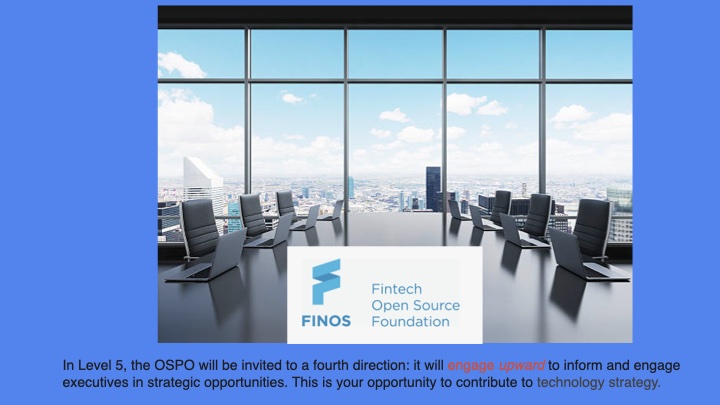
This is an invitation to take action. Join us in discussing the concerns of top executives in your organization and how open-source technology should play a crucial role in their decision-making. These choices should be condensed into a concise list that can be thoroughly reviewed in a single boardroom meeting.